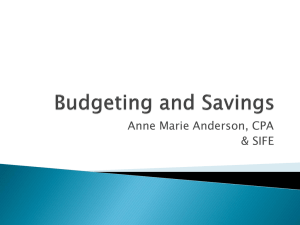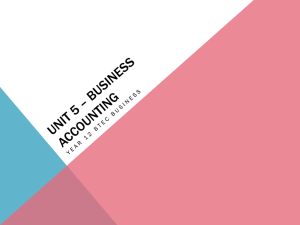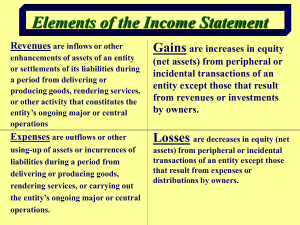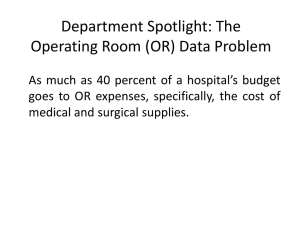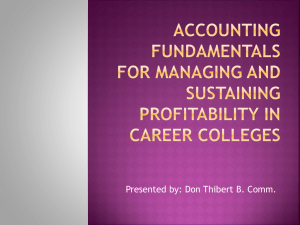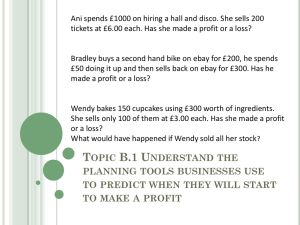Slides from Finance Workshop - U
advertisement
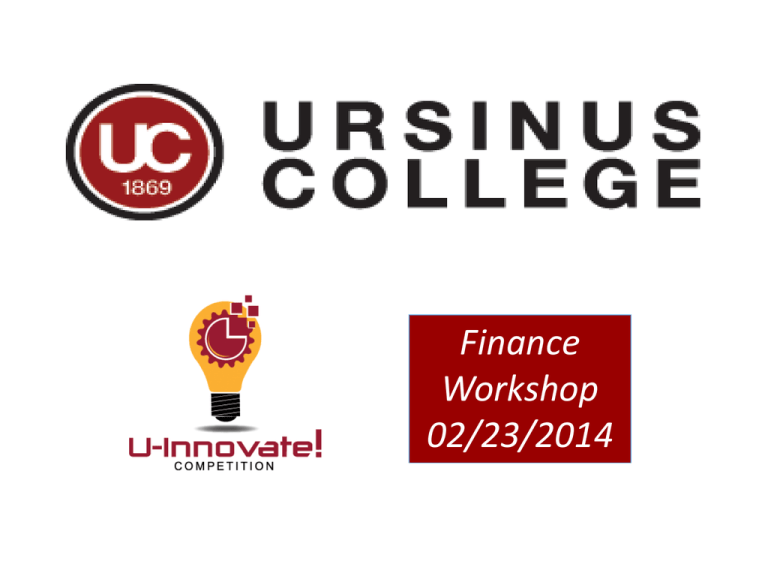
Finance Workshop 02/23/2014 Agenda / Table of Contents 6:00 to 6:30 6:30 to 7:00 7:00 to 7:45 7:45 to 8:00 • Introductions • Making a Case for Financial Sustainability • Basic Financial Information • Income Statement • Cash Flows, Balance Sheet, Breakeven • Sample Exercise • Recap • Q&A • Appendix - Glossary U-Innovate! Competition 2 Ask Questions & Take Breaks as needed Introductions Workshop Facilitator - Mike Gibson •BS in Accounting, Master of Business Administration •30+ years experience in Corporate Accounting and Finance •Colonial Penn Life, GE Financial Assurance, ING US •10+ years small business experiences as officer/treasurer of HOA U-Innovate! Teams •Team members •Team Project Description Name Major Academic Year Faculty Leaders •Carol Cirka - Business and Economics •Rebecca Jaroff – English •April Kontostathis – Mathematics and Computer Science U-Innovate! Competition 3 Making a Case for Financial Sustainability Financial sustainability - achieved when a venture is able to deliver products and services to the market at a price that covers their expenses over the long term. In the assessment of financial sustainability: •Economic logic is present and estimates seem to be based on reasonable assumptions, i.e.: •Price to the customer, costs, sales needed to breakeven, sales forecast, gross margin, etc. •Estimates indicate that the venture has significant potential for financial sustainability. Financial Sustainability requires the team to apply finance concepts in understanding, tracking and managing its revenues and costs! U-Innovate! Competition 4 Elements of Information for Financial Sustainability Basic Financial Statements •Income Statements - Revenue, Expenses •Balance Sheet •Statements of Cash Flow Assumptions •Time Horizon – 3 to 5 years •Source of Capital/ Financing •Company organization – e.g. For-Profit vs. Non-profit •Source and Estimates of Revenues •Methods/source for developing cost assumptions Analytics •Break Even Analysis, Other Metrics •Relevant Benchmarks/Comparisons to Peer Companies Supporting Documents – leases, licenses, loans, etc. U-Innovate! Competition 5 Financial Information – Income Statement Revenue Expenses Income realized in a period related to normal business activities Costs incurred in a period related to the generation of revenue Sources of Revenue •Cost of materials •Labor related to the production or sale of goods/services Cost of Sales - variable •For Profit vs. Non-profit Types of Revenue: General and Admin Expenses •One-time •Fixed Costs – Administrative & Overhead Expenses oProduct sales oSoftware license •Salaries/staff expenses – employees not related to production •Rent •Recurring oSoftware maintenance •Other Costs •Recognition factors •Recognition factors U-Innovate! Competition 6 Other Financial Data Balance Sheet Assets = Liabilities & Equity $ Revenue Cash Flow: •Operations •Source of cash to fund start-up •Time to break-even •Investing – buying, selling assets •Financing – changes in debt, equity Analytics 7 Total costs Fixed costs 0 •Break-even analysis U-Innovate! Competition Breakeven Units Financial Statements – Pulling it Together Income Statement Revenue per Unit minus Net Sales (Revenue) COS per unit = -Cost of Sales (COS) Gross Profit Margin = Gross Profit -Fixed operating costs (except depreciation) = Earnings Before Interest, Taxes, Depr & Amort (EBITDA) -Depreciation and amortization = Net Operating Income = EBIT -Interest = EBT -Taxes = Net Income Cash Flow: Net Income + Depreciation & Amortization (non-cash) = Net Cash Flow U-Innovate! Competition 8 Exercise – Pop-a Bears Popcorn Company! Assumptions •Start-up •One F/T employee •Two P/T employees •Campus retail location •Selling Prices •Plain = $3.00 •Caramel = $3.50 •Drinks = $1.00 •Gross profit margin = $2.50 Sales Opportunity •Healthy snack •Easy to carry around •Gaining in popularity •Geographic advantage •No direct competition U-Innovate! Competition Revenue & Expense Exercise 9 Pop-a Bears Popco – Assumptions Operating Assumptions •Campus location in Student Union, and presence at activities (football, etc.) •One full-time employee – owner/manager •Two part-time student employees •1st year operations grade up; normalized volume of 18k units attained in year 2 •Offering popcorn and cold beverages •Research shows that popcorn consumption will grow 20% annually with collegeage groups, with high potential for repeat business Assumptions Year 1 Year 2 Year 3 Year 4 Year 5 # Units - Plain 6,000 12,000 14,400 17,280 20,736 # Units - Caramel 3,000 6,000 7,200 8,640 10,368 Total Units 9,000 18,000 21,600 25,920 31,104 # Beverages - 50% of sales 4,500 9,000 10,800 12,960 15,552 120% 144% 173% Annual Sales Growth = 20% # of students, staff, visitors 20% 4,500 Penetration Units per year Units year 1 U-Innovate! Competition 50% 100% Total Fixed Costsper year = $70,000 40% Average Sale = $3.67 10.00 Total Variable Costs per unit = $1.17 18,000 Gross Profit Margin per unit = $2.50 10 Pop-a Bears Popco –Breakeven Analysis PxQ = FC + VC x Q Q = FC/(P-VC) Pop-a Bears Popco Breakeven Analysis Weighted Average Price Year 1 Total Revenue Total Units Average Price (P) $ B/E Volume 70000/ (3.667-1.167) 28,000 Year 2 Year 3 Year 4 Year 5 33,000 66,000 79,200 95,040 114,048 9,000 18,000 21,600 25,920 31,104 3.667 $ 3.667 $ 3.667 $ 3.667 $ 3.667 Costs Total Fixed Costs (FC) 70,000 70,000 70,000 70,000 70,000 Total Variable Costs 10,500 21,000 25,200 30,240 36,288 9,000 18,000 21,600 25,920 31,104 Total Units Average Variable Cost (VC) $ Net Income(Loss) Net Income(Loss) - cumulative 1.167 $ 1.167 $ 1.167 $ 1.167 $ 1.167 $ (47,500) $ (25,000) $ (16,000) $ (5,200) $ 7,760 $ (47,500) $ (72,500) $ (88,500) $ (93,700) $ (85,940) Breakeven Example Exercise U-Innovate! Competition 11 Pop-a Bears Popco – Financial Projections Year 1 Revenue Plain Caramel Beverages Total Revenue Expenses - Variable Cost of materials - plain Cost of materials - caramel Cost of packaging Beverages Total Variable Expenses $ $ $ Unit Cost 3.00 $ 18,000 3.50 $ 10,500 1.00 Equipment/Leaseholds Total Fixed Expenses EBITDA (cash flow) Depreciation - 5 year basis Net Income(Loss) Before Taxes U-Innovate! Competition 4,500 33,000 Year 3 Year 4 Year 5 $ $ 36,000 21,000 $ $ 43,200 25,200 $ $ 51,840 30,240 $ $ 62,208 36,288 $ 9,000 66,000 $ 10,800 79,200 $ 12,960 95,040 $ 15,552 114,048 $ $ $ 0.50 1.00 0.25 3,000 3,000 2,250 6,000 6,000 4,500 7,200 7,200 5,400 8,640 8,640 6,480 10,368 10,368 7,776 $ 0.50 2,250 10,500 4,500 21,000 5,400 25,200 6,480 30,240 7,776 36,288 22,500 45,000 54,000 64,800 77,760 $40,000 $10,000 $15,000 $ 4,000 40,000 10,000 15,000 4,000 40,000 10,000 15,000 4,000 40,000 10,000 15,000 4,000 40,000 10,000 15,000 4,000 40,000 10,000 15,000 4,000 $ 5,000 5,000 74,000 69,000 69,000 69,000 69,000 (51,500) (24,000) (15,000) (4,200) 8,760 (4,000) 1,000 1,000 1,000 1,000 Gross Profit Fixed Expenses Staff Expenses F/T - Fixed Staff Expenses P/T - Fixed Rent - 5 year lease Other Expenses $ Year 2 $ (47,500) $ (25,000) 12 $ (16,000) $ (5,200) $ 7,760 What are the actions to improve profitability? Breakeven in year 5 Summary – Q&A U-Innovate! Competition 13 Appendix - Glossary •Income Statement -shows sources of revenues and expenses for certain periods •Revenue - income that a company receives from its normal business activities, usually from the sale of goods and services to customers. •Expense - an outflow of cash or other valuable assets from a person or company to another person or company. •Variable Cost - A periodic cost that varies in step with the output or the sales revenue of a company. •Fixed Cost - A cost that does not change with an increase or decrease in the amount of goods or services produced. •Gross Profit - Revenue less Cost of Sales (COS) •Gross Profit Margin - Revenue per unit less COS per unit. •Breakeven – Revenue = Expenses. Price x Quantity = Fixed Cost + (Variable Costs x Quantity) •Nonprofit - an organization that uses surplus revenues to achieve its goals rather than distributing them as profit or dividends. While not-for-profit organizations are permitted to generate surplus revenues, they must be retained by the organization for its selfpreservation, expansion, or plans. U-Innovate! Competition 14
